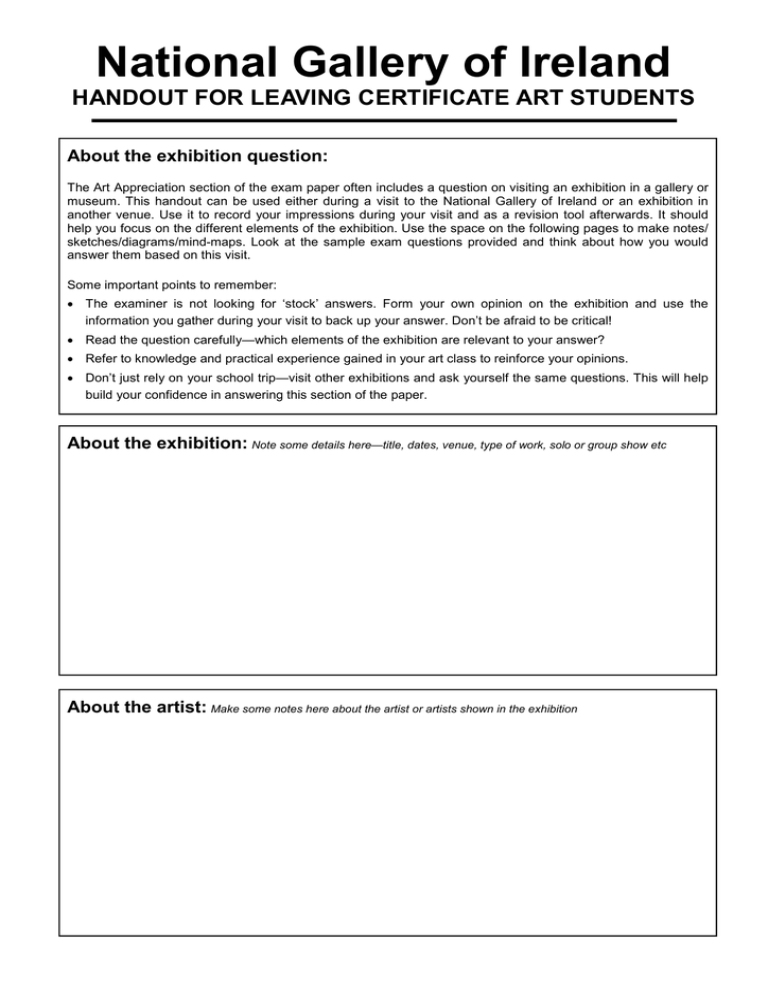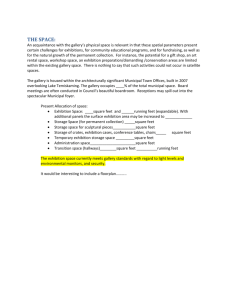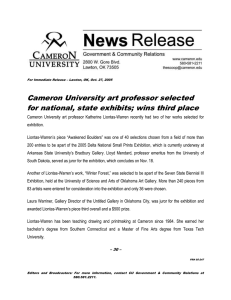NGI Exhibition Question Handout
advertisement

National Gallery of Ireland HANDOUT FOR LEAVING CERTIFICATE ART STUDENTS About the exhibition question: The Art Appreciation section of the exam paper often includes a question on visiting an exhibition in a gallery or museum. This handout can be used either during a visit to the National Gallery of Ireland or an exhibition in another venue. Use it to record your impressions during your visit and as a revision tool afterwards. It should help you focus on the different elements of the exhibition. Use the space on the following pages to make notes/ sketches/diagrams/mind-maps. Look at the sample exam questions provided and think about how you would answer them based on this visit. Some important points to remember: • The examiner is not looking for ‘stock’ answers. Form your own opinion on the exhibition and use the information you gather during your visit to back up your answer. Don’t be afraid to be critical! • Read the question carefully—which elements of the exhibition are relevant to your answer? • Refer to knowledge and practical experience gained in your art class to reinforce your opinions. • Don’t just rely on your school trip—visit other exhibitions and ask yourself the same questions. This will help build your confidence in answering this section of the paper. About the exhibition: Note some details here—title, dates, venue, type of work, solo or group show etc About the artist: Make some notes here about the artist or artists shown in the exhibition Layout, Lighting, Space... This section focuses on how the works are displayed and how it impacts on your experience of the works. You don’t have to answer every question—use them to help you form your own opinion! First look at the architecture: Is it an old or new building? Are there high ceilings, pillars, doorways or other architectural features that affect how the work is displayed? Do you think the wall colour matters? Look at the space: The use of space in exhibitions can provoke psychological responses—do you feel comfortable? Are the rooms crowded and busy or calm? Is there plenty of space around the artworks or are they close together? How does this affect the exhibition? What sort of atmosphere is created? Look at the lighting: Did you notice a change in light levels when you enter the exhibition? It may take a few minutes for your eyes to adjust. Delicate artefacts and works on paper need very low lighting to protect them. Is the use of lighting effective? Does it add to the exhibition? Look at the layout: How many rooms does the exhibition take up? Are there different themes or types of work grouped together? Are works of a similar size or shape grouped together? Are the works at eye-level? Do a quick sketch of any aspects of the layout and design of the exhibition you think might be important. Sample exam questions focusing on display: If you were offered a number of the works from this exhibition on loan to your school suggest a suitable location to display them. Discuss layout, lighting and any other aids you would use to enhance the display. Analyse the layout, lighting and general presentation of an exhibition of art, design or craft you have visited, saying whether or not these were effective, and why. Access, Information, Engagement... The National Gallery of Ireland is a national cultural institution. We place great importance on active engagement with our audiences. This section looks at issues of access—there’s lots to think about here! Look at access to the exhibition: Is there an admission charge to the exhibition? Are concession rates available? Do you think it is affordable? Does the Gallery appear welcoming and open? What about physical access? Is the Gallery easy to get to using public transport? Is the exhibition space accessible to visitors using wheelchairs? Is it easy to find your way around? What about sensory impairments? The National Gallery provides copies of the labels and text panels in large print format for visitors with visual impairments. Tours are also available for hard-of-hearing and deaf visitors. Other venues may provide other resources to aid accessibility, such as a loop system for audio etc Look at what information is available: Is there clear signage? What about publicity material—leaflets, posters, advertising? Did you see any publicity or reviews of the exhibition before you visited? Look at the catalogue and website: do you think they help your appreciation of the works? Is it important for a venue to provide these additional services? Exhibitions can use individual labels or contextual text panels giving an overview of the different themes or a combination of both. Which approach is used in this exhibition? Or is there another approach used? Take a closer look at a text panel or label— is it easy to understand? Is it telling you what you want to know about the work? What else would you include in the label? Some curators prefer to let the works stand on their own and provide little or no information, and some curators provide layers of additional information. Is the information provided sufficient? Is it accessible? Look at the public programmes: Are there any events running with the exhibition? Are there talks or lectures? Are there tours available? Do you think it is useful to have activities to accompany an exhibition? Can you think of other ways that the Gallery could improve its contact with the public? We welcome new ideas and suggestions so if you’ve got one please fill in a comment card in reception before you leave! You can also give feedback via our website www.nationalgallery.ie, our facebook page www.facebook.com/NationalGalleryofIreland, or via twitter.com/NGIreland Sample exam questions focusing on access: Exhibition catalogues, information sheets and tourist guides can provide reference information for a visit to an art gallery, museum or national monument. (a) Describe, in your own words, how such information impacted on your visit to a gallery, museum or national monument and (b) Discuss the characteristics of a good catalogue. Based on a visit you made to a museum or art gallery, describe and discuss how the museum/gallery tried to inform and engage visitors with the artefacts on display. Your favourite works... Use this space to sketch and record details about 2 works in the exhibition that interest you. Drawing a work helps to fix it in your memory. Don’t forget to note the name and date of the work! Think about some of the following in relation to each work: What type of work is it—painting, print, photograph, drawing, sculpture, object, installation? What medium is used—oil, watercolour, ink, fabric, wood, metal, mixed media? What is the subject matter? What is the style? Look at the composition—is it a solitary figure or a group? How are they positioned in relation to each other? Is it a landscape or interior scene? Are there any notable elements to the composition? Do you like it? Does it provoke a personal response? Do you think it might influence your own work? Sample exam questions focusing on the artworks: A visit to an exhibition is best judged by the quality of art work on display and by the gallery space itself. Discuss this statement with reference to any named exhibition you have visited. Discuss how a visit to a gallery or museum impacted on your appreciation of art and how it influenced your own artwork. Name the gallery or museum and refer to two specific examples of work in your discussion. Describe and discuss in detail TWO artefacts from the exhibition, referring in your answer to subject matter, composition, use of materials and/or colour, and style. © The National Gallery of Ireland 2010

